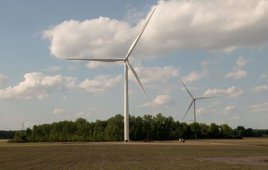An area in Texas with four of the world’s largest wind farms has showed an increase in land surface temperature over nine years, a phenomenon catching the attention of scientists. Researchers have connected the local meteorological effects to wind turbines.
The land surface temperature around the west-central Texas wind farms warmed at a rate of 0.72°C/decade relative to nearby regions without wind farms, according to a study by the University of Albany, State University of New York. The effect is most likely caused by the turbulence in turbine wakes acting like fans to pull down warmer air from higher altitudes at night, lead author Liming Zhou says.
 Zhou and colleagues studied land surface temperature data from 2003 to 2011, from the MODIS instruments on NASA’s Aqua and Terra satellites.
Zhou and colleagues studied land surface temperature data from 2003 to 2011, from the MODIS instruments on NASA’s Aqua and Terra satellites.
Land-surface temperatures measure the temperature of the Earth’s surface, as opposed to the air-temperature readings used in daily weather reports. Across a broad landscape, land-surface temperature depends on the land cover type and nature of the surface. Land surface temperature varies widely from day to night while air temperature varies within a smaller range.
The warming observed by MODIS mostly occurred at night. In the Texas region studied, the land surface temperature after sunset typically cools faster than the air temperature. But as the wind turbines continued to turn, the movement brought warmer air to the surface and thus created a warming effect compared to non-wind farm regions. The researchers expected to see the reverse during the day, but the data instead showed a small warming or negligible effect in daytime.
The warming estimate applies to this particular region, and covers a time when wind farms were expanding rapidly, Zhou says. The estimate should not be considered directly applicable for other regions and landscapes, nor should it be extrapolated over a longer period of time, as the warming would likely plateau rather than continue to increase if no new wind turbines are added, the researchers hypothesize. The warming is also considered a local effect, not one that would contribute to a larger global trend.
“This is a first step in exploring the potential of satellite data to quantify the possible impacts of big wind farms on weather and climate,” says Chris Thorncroft, a coauthor of the study and chair of the Aospheric and Environmental Sciences department at University at Albany, State University of New York. “We are now expanding this approach to other wind farms and building models to understand the physical processes and mechanisms driving the interactions of wind turbines and the aospheric boundary layer near the surface.”
The U.S. wind industry has installed a total of 46,919 MWs of capacity through the end of 2011 – representing more than 20% of the world’s installed wind power and about 2.9% of all U.S. electric power – and has added more than 35% of all new U.S. generating capacity in the past four years, according to the American Wind Energy Association and the Department of Energy. This added capacity during that timeframe is second only to natural gas, and more than nuclear and coal combined.
“Wind power is going to be a part of the solution to the climate change, air pollution, and energy security problems,” says Somnath Baidya Roy at University of Illinois, Urbana-Champaign, a co-author of the study. “Understanding the impacts of wind farms is critical for developing efficient adaptation and management strategies to ensure the long-term sustainability of wind power.”
University of Albany, State University of New York
www.albany.edu
Filed Under: Uncategorized





Liming Zhou, Somnath Baidya Roy and Chris Thorncroft,
I think the basic premise of your theory is in error. Given that the large wind turbine farms extract energy from the moving wind column, energy being heat, the wind column is actually cooled by the large wind turbine farms. This is proven graphically by the popular photographs of the European offshore wind turbines (Horns Reve) in which contrails of cooled air flowed downwind from the wind turbines. The picture beautifully illustrated the phenomenon of humidity, temperature, and pressure being perturbed by the extraction of a fraction of a degree of temperature as the air column is cooled by the wind turbines. The discussion of them being “fans” demonstrates a misunderstanding of the physical reality of the technology.
The hypothesis claims the opposite. So how does air cooled from energy extraction by wind turbines, then warm up the land, try again. Perhaps there is a subtle non-objective selectivity for your temperature comparison data of non-windfarm areas which has unintentionally prejudiced the conclusions.
Wind turbines remove energy from the wind. They are not fans blowing air and adding energy to the wind, as the article seemed to suggest. There may be some other physical principal causing your perception of the warming, but it isn’t the wind turbines. Given that the sun’s insolation contribution to heating a high thermal mass such as the ground is much greater than the sun’s heating of the low thermal mass air above, perhaps it is changes in cloud cover or changes in the solar radiation absorbtivity of the ground’s surface.
Migraine headaches, epilepsy, spontaneous miscarriage, hyperactivity, etc. are no more the fault of wind turbines today than were the identical allegations in the early 1800’s the fault of “Tom Thumb” the first passenger train, or in the early 1900’s of the early automobiles speeding past the regularly spaced fence posts on country roads.
That is the big picture concept of wind energy wherein the wind farms actually move heat energy from the wind regions to then heat up the non-wind areas of the metropolitan areas through the intense consumption of electricity which necessarily concludes in the addition of heat energy to that location where the electricity is consumed. We would therefore expect to see a heating of the cities as an instantaneous displacement of heat energy from the wind regions to the more inhabited areas.
But then one would also need to compare that effect with the consumption of coal, wherein the solar energy from the sun contributed to making the chemical energy of coal eons ago, so the heating of the planet from coal combustion today is simply the release of the natural energy of the sun from eons ago. I guess that makes coal combustion in a thermal energy electric generator plant just another form of solar energy, simply displaced in time?
Thanks for your comments, Mr. Chase.
The researchers were simply reporting their data. Mr. Roy reported in another study (https://www.windpowerengineering.com/policy/environmental/wind-power-cools-global-warming%E2%80%A6locally-anyhow/) that found wind farms cooling crops, and concluded after the Texas study the phenomena is local. In the end it points to how little we know about natural phenomena the sea of air in which we live.